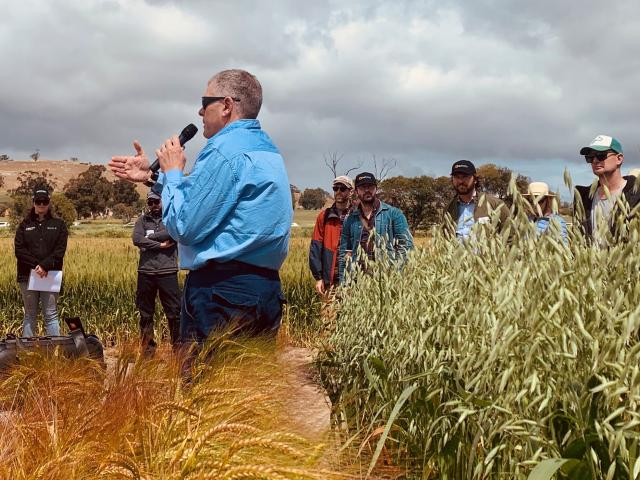Boosting grain yield of milling oats to rival wheat and barley
Project name
Building grain yield (without neglecting physical grain quality) in milling oats through a better understanding of source and sink relationships and developing a targeted selection toolbox for future breeding gains.
What the project will discover
A new project aims to increase the rate of genetic gain for grain yield of milling oats in Western Australia so that it matches, or even exceeds, that being achieved for wheat and barley.
The project, funded by the Processed Oats Partnership (POP), is a partnership between the Department of Primary Industries and Regional Development (DPIRD), led by senior research scientist Blakely Paynter, and breeding company InterGrain, with support from oat breeder Allan Rattey.
While barley and wheat have had the benefit of technological advances to enhance yield potential, such as marker assisted breeding, researchers are now realising the potential of this technology with oats.
With large genomic resources to be available by the end of the year, via co-investment in the Global PanOat consortium by the Grains Research and Development Corporation (GRDC) and participating research organisations, inclduing the Western Crop Genetics Alliance, genomic breeding that enables increased yield will be possible for oats in the foreseeable future.
However, before applying genomic selection, DPIRD researchers must understand what physiological attributes need genetic improvement, through breeding and/or selection, to improve grain yield and the stability of physical grain quality.
As part of this project, researchers will obtain access to a wide range of national and international germplasm to ensure the widest possible source of key traits are evaluated for their potential in the WA environment.
Another part of the project will determine how many environmental types exist in WA, in order to understand if physiological attributes of grain yield and physical grain quality differ across these environmental types.
According to Dr Rattay, this information will help InterGrain optimise where it places its selection sites and may influence National Variety Trials (NVT) locations in future.
Future benefit to growers
Mr Paynter said this project is about a series of small steps involving detailed science with significant practical outcomes.
The phenotyping being undertaken will assist InterGrain to determine its target traits and if these vary between environmental types.
With this data, InterGrain aims to optimise its trial site network for improved efficiency and drive its breeding targets to result in better varieties available to WA growers and, more broadly, nationally.
According to Mr Blakely, the project won't result in an overnight change the yields achieved from milling oats, however it will develop the base physiological information required to drive yield improvement in oats, so it remains a competitive option in the farming system in coming years.
Specific trial information
The project will undertake field-based phenotyping of oat germplasm from Australian and non-Australian origin (with appropriate phenology) in different environments in WA.
A core panel of lines (up to 60) will be phenotyped for source (entire above ground crop biomass at the beginning of grain fill) and sink (total grain number and size) relationships, yield components, grain yield and physical grain quality.
DPIRD research scientist, Dr Hamid Shirdelmoghanloo, who will manage the phenotyping component of the project, explained detailed phenotyping will only occur in two environments, one north of the Great Eastern Highway and the other south of the highway.
This work will include measuring many traits on individual leaves, stems and panicles.
For example, the grain from 7200 panicles from the 2022/23 harvest will be separated into primary, secondary and tertiary kernels to determine where the yield of different varieties is developed in the panicle.
A sub-set of the core panel will be phenotyped in more detail for source and sink relationships by manipulating assimilate supply, increasing source capacity relative to the sink, and estimating potential assimilate supply.
This will involve shading some plants during grain filling, removing their flag leaves to limit the source of assimilates available to the panicle, or removing grains from the panicle to increase the sink size.
The core panel will also be screened in other environments, but for fewer traits and without detailed phenotyping, with the number of environments in which the core panel of lines will be screened to expand from four in 2022 to eight in 2023.
Simultaneously, a diversity panel (up to 600 lines) will be screened for grain yield and physical grain quality, with novel diversity from this panel selected for detailed phenotyping in the core panel in subsequent years.
The project will utilise imaging from a drone carrying a multispectral camera which collects data on biomass and other canopy traits at incredibly high resolutions, as well as through-put, to assist in phenotyping the core and diversity panels.
A history of oats in WA
WA is the leading export state for oats in Australia, contributing 90 per cent of processed oat exports and 70 per cent of raw oat exports, with the trade of both from WA accounting for just under 10 per cent of world trade.
Australia’s major competitor, Canada, has seen oat production rising since 2010 due to improved genetics and better management practices, however in WA there has been no genetic gain for grain yield in milling oats since the release of Bannister and Williams in 2012.
Genetic gain for grain yield of milling oats has stagnated over the past two decades and as a result, the State government, through this project, is assisting InterGrain so its yield gain will match that of wheat and barley.
Funding partners
Western Australian Processed Oats Growth Partnership (POP).
More information
Contact
Blakely Paynter
DPIRD senior research scientist
M: 0427 988 098
E: blakely.paynter@dpird.wa.gov.au
Allan Rattey
InterGrain national oat breeder
M: 0448 319 425
E: arattey@intergrain.com

